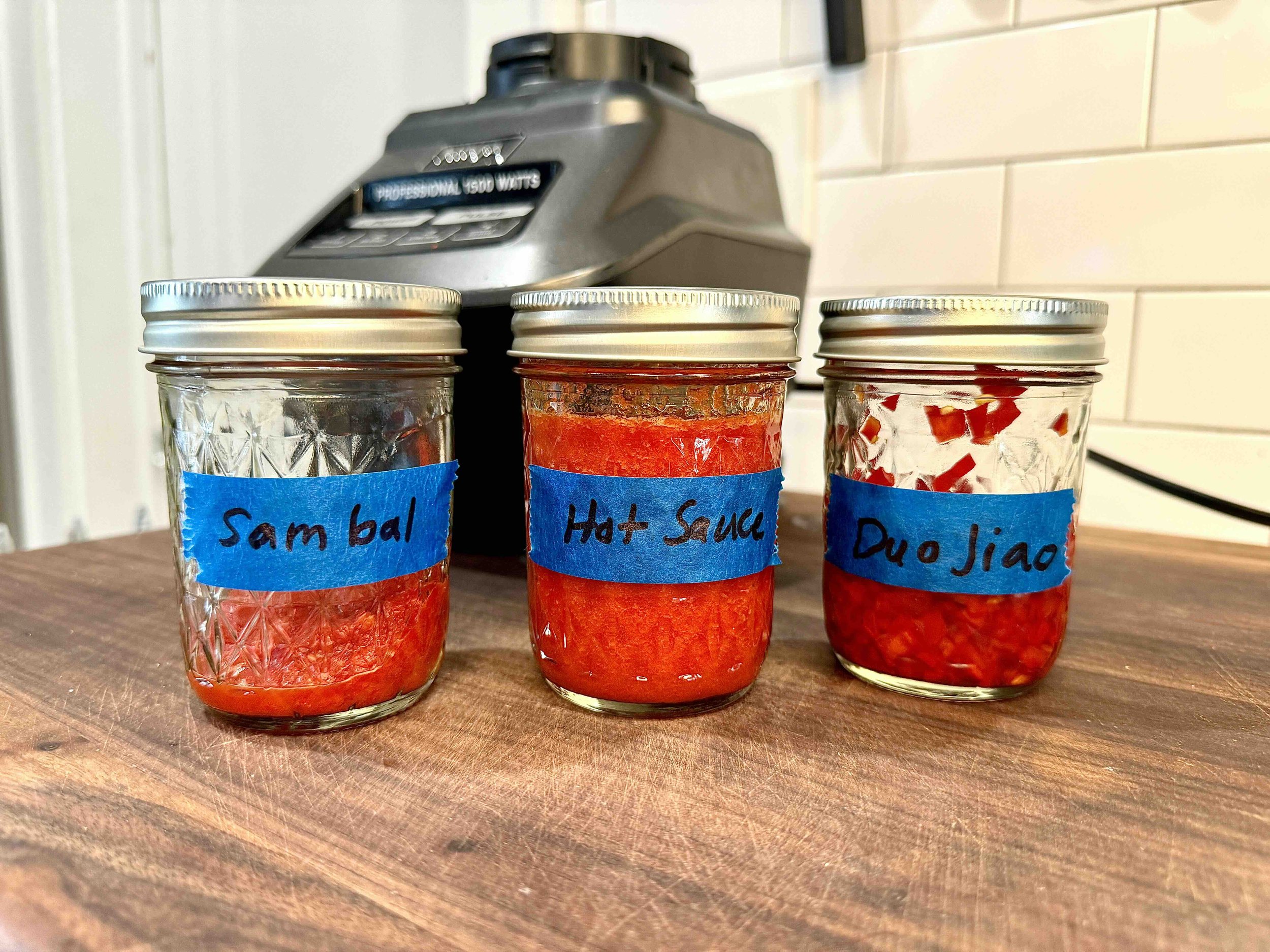Hot and Tangy: 3 Creative Uses for Fermented Chilis
From left to right: sambal (Southeast Asian ground chili paste), fermented hot sauce, and duo jiao (fermented chili relish from Chinese Hunan cuisine).
3 Creative Uses for Fermented Chilis
This project began on a weeknight when I had a strong craving for kung pao chicken, also known as gong bao chicken, a popular dish from Hunan cuisine. The key ingredient is duo jiao, salted and fermented chilies. Despite the many wonderful Asian markets in Jacksonville and the availability of online specialty stores, this condiment is still hard to find but surprisingly easy to make. So, I decided to make it myself, starting with the base recipe from The Woks of Life with a few adjustments of my own. Be warned: I like a lot of heat so I included two Habanero peppers in my fermented chilis, feel free to exclude them. Anaheim chilies have a more mild level of heat.
So why go through all of the trouble to make this? Well, I like efficiency and creating as little food waste as possible. This is a project that easily comes together during a slow weekend afternoon especially for those who are up to their eyeballs with summer pepper crops. Here’s what you can make with a single batch of peppers:
Duo Jiao
Duo jiao is a fermented chili relish popular in Chinese Hunan cuisine. It’s a common ingredient in stir-fry dishes like Kung Pao Chicken (Gong Bao Di Jing) and steamed dishes like Duo Jiao Yu (Hunan steamed fish with fermented chilis). Its bold flavors bring a distinctive heat and depth to any dish.
Classic Fermented Hot Sauce
Move over Krystal and Tabasco; homemade fermented hot sauce with a touch of vinegar offers so much more flavor than store-bought options. The best part is that it's fully customizable. Want more garlic? No problem. Prefer less vinegar? Go for it! Additionally, it’s a fermented product that aids digestion and helps your body absorb nutrients more efficiently.
Sambal
This recipe provides a simplified version of sambal, but it's still incredibly tasty. Typically, sambal is a Southeast Asian, primarily Indonesian condiment, eaten raw or in cooked dishes. Traditional sambal includes ingredients like shrimp paste, ginger, shallot, scallion, palm sugar, and lime juice. Feel free to customize it further once you have your fermented chilis ready.
Enjoy these delicious and versatile fermented chili products, each bringing its unique flavor and benefits to your meals!
Ingredients for the Salted, Fermented Chilies
12-14 red jalapeños or Fresno chilies
2 habanero peppers
3 tablespoons fine Kosher salt
1 1/2 tablespoon sugar
3 tablespoons clear Shaoxing wine
Special Equipment
Two, 8 oz mason jars, sterilized
Gloves
Directions for Fermented Chili Base
Start by thoroughly washing your peppers in cold water. Ensure your jars, cutting board, and knife are sanitized by washing them with warm water and soap, followed by a swipe with an alcohol wipe. A clean workspace is essential to prevent any harmful bacteria from contaminating your fermented chilies.
Put on your gloves and cut the stems and tips off each chili pepper. Slice the peppers in half and remove as many seeds as possible, discarding the seeds and stems. Don’t worry about trimming out the white membranes; they will add a bit of heat to your ferment. Slice each chili half into thin strips, then finely mince them to achieve a relish-like consistency.
Transfer the minced chilies to a medium bowl and add salt, sugar, and Shaoxing wine. Let the mixture steep for one hour. Afterward, distribute the mixture evenly into the sterilized jars. Cover the surface of the chili mixture with a double-folded piece of plastic wrap to prevent airflow. Then, seal the jars with their lids. Allow the chilies to ferment in a cool, dark place for two weeks. If you notice any mold or fuzzies growing on the surface of your ferment, you’ll need to discard :[
Directions for Fermented Hot Sauce and Sambal
Take one of your spare fermented chili jars and add 4 cloves of garlic, 3 tablespoons of distilled white vinegar, and 1/4 teaspoon of sugar. Customize to your taste, but this is a solid starting point.
Blend the mixture using a high speed blender, then transfer it to a bowl lined with cheesecloth or a fine mesh sieve. Allow the liquid to collect in the bowl while gently pressing on the solids.
Bottle the hot sauce and store it in the fridge for up to one month. The chili solids left from the extraction can be used as a basic sambal. For a more authentic Indonesian flavor, mix in ginger and shrimp paste. The sambal can also be stored for up to a month in the fridge.
